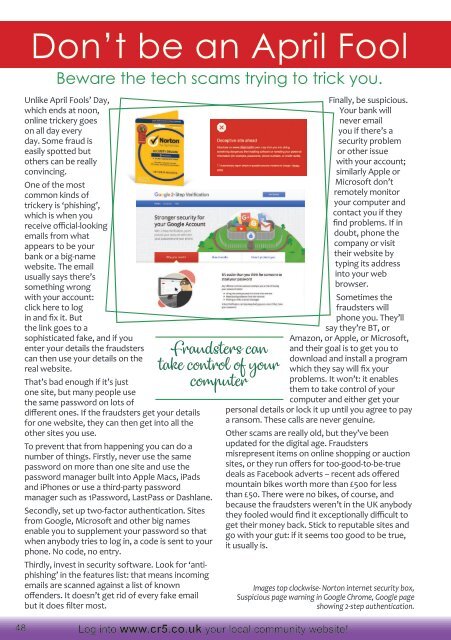CR5 Issue167 April 2019
A local community magazine delivered free to 11,700 homes every month in the CR5 postcode. Contains local business advertising,interesting reads, Competitions, What's on in the Community and puzzles.
A local community magazine delivered free to 11,700 homes every month in the CR5 postcode.
Contains local business advertising,interesting reads, Competitions, What's on in the Community and puzzles.
Create successful ePaper yourself
Turn your PDF publications into a flip-book with our unique Google optimized e-Paper software.
Don’t be an <strong>April</strong> Fool<br />
Beware the tech scams trying to trick you.<br />
Unlike <strong>April</strong> Fools’ Day,<br />
which ends at noon,<br />
online trickery goes<br />
on all day every<br />
day. Some fraud is<br />
easily spotted but<br />
others can be really<br />
convincing.<br />
One of the most<br />
common kinds of<br />
trickery is ‘phishing’,<br />
which is when you<br />
receive official-looking<br />
emails from what<br />
appears to be your<br />
bank or a big-name<br />
website. The email<br />
usually says there’s<br />
something wrong<br />
with your account:<br />
click here to log<br />
in and fix it. But<br />
the link goes to a<br />
sophisticated fake, and if you<br />
enter your details the fraudsters<br />
can then use your details on the<br />
real website.<br />
That’s bad enough if it’s just<br />
one site, but many people use<br />
the same password on lots of<br />
different ones. If the fraudsters get your details<br />
for one website, they can then get into all the<br />
other sites you use.<br />
To prevent that from happening you can do a<br />
number of things. Firstly, never use the same<br />
password on more than one site and use the<br />
password manager built into Apple Macs, iPads<br />
and iPhones or use a third-party password<br />
manager such as 1Password, LastPass or Dashlane.<br />
Secondly, set up two-factor authentication. Sites<br />
from Google, Microsoft and other big names<br />
enable you to supplement your password so that<br />
when anybody tries to log in, a code is sent to your<br />
phone. No code, no entry.<br />
Thirdly, invest in security software. Look for ‘antiphishing’<br />
in the features list: that means incoming<br />
emails are scanned against a list of known<br />
offenders. It doesn’t get rid of every fake email<br />
but it does filter most.<br />
Fraudsters can<br />
take control of your<br />
computer<br />
48 Log into www.cr5.co.uk your local community website!<br />
Finally, be suspicious.<br />
Your bank will<br />
never email<br />
you if there’s a<br />
security problem<br />
or other issue<br />
with your account;<br />
similarly Apple or<br />
Microsoft don’t<br />
remotely monitor<br />
your computer and<br />
contact you if they<br />
find problems. If in<br />
doubt, phone the<br />
company or visit<br />
their website by<br />
typing its address<br />
into your web<br />
browser.<br />
Sometimes the<br />
fraudsters will<br />
phone you. They’ll<br />
say they’re BT, or<br />
Amazon, or Apple, or Microsoft,<br />
and their goal is to get you to<br />
download and install a program<br />
which they say will fix your<br />
problems. It won’t: it enables<br />
them to take control of your<br />
computer and either get your<br />
personal details or lock it up until you agree to pay<br />
a ransom. These calls are never genuine.<br />
Other scams are really old, but they’ve been<br />
updated for the digital age. Fraudsters<br />
misrepresent items on online shopping or auction<br />
sites, or they run offers for too-good-to-be-true<br />
deals as Facebook adverts – recent ads offered<br />
mountain bikes worth more than £500 for less<br />
than £50. There were no bikes, of course, and<br />
because the fraudsters weren’t in the UK anybody<br />
they fooled would find it exceptionally difficult to<br />
get their money back. Stick to reputable sites and<br />
go with your gut: if it seems too good to be true,<br />
it usually is.<br />
Images top clockwise- Norton internet security box,<br />
Suspicious page warning in Google Chrome, Google page<br />
showing 2-step authentication.
















